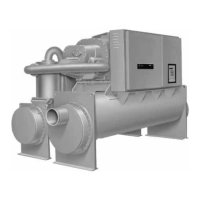Compressor Load-Unload Solenoid
RTHC-SVD01B-EN 37
Section 6 Compressor Load-Unload Solenoid
6-1. General
RTHC compressors are loaded and unloaded by means of an internal
slide valve. In simple terms, the valve can regulate the amount of “bite”
of the compressor rotors as they turn at relatively constant speeds.
The slide valve is moved by a piston located at the discharge end of
the compressor. The hydraulic fluid is R-134a, unlike the RTHB com-
pressor which uses oil. The movement of the piston is controlled by the
load and unload solenoid valves, which either add refrigerant pressure
from the high pressure side or relieve pressure to the low pressure
side of the system.
Although the solenoids are “on - off” devices, effective modulation and
high resolution of the slide valve (under steady state conditions) is pos-
sible by pulsing the solenoid valves on and off and varying the dis-
placed volume of the cylinder/piston. When the compressor is
operating, the 1U1 Chiller module will energize (apply 115 VAC) either
the load or the unload solenoid, as necessary. The solenoids are ener-
gized for a period of between 40 and 400 milliseconds, once every 5
seconds to control the leaving evaporator water temperature or limit
conditions.
After a compressor stop, the unload solenoid valve will remain ener-
gized for 60 minutes to prevent slide valve movement due to changing
cylinder/compressor pressures.
The procedure below will allow the checkout of the Chiller module load
and unload outputs. The subsequent procedure will allow the checkout
of the load and unload solenoid valves located on the compressor as
well as the operation of the slide valve piston.
6-2. Check Procedure for 1U1 Load-Unload
Outputs
The 1U1 controls the load and unload solenoid valves on the compres-
sor with 115/220 VAC triacs (solid state relays). Unlike mechanical
relays, a triac has a rather high leakage current when off speaking.
While this leakage is not nearly enough to actuate a solenoid valve, it
may, under no load conditions (as would be experienced when a sole-
noid coil failed open), look like it was stuck “on” when using a voltmeter
to test it. It is important to verify that the solenoid coil is providing a nor-
mal load. Connecting a known good load, such as a low wattage 115

